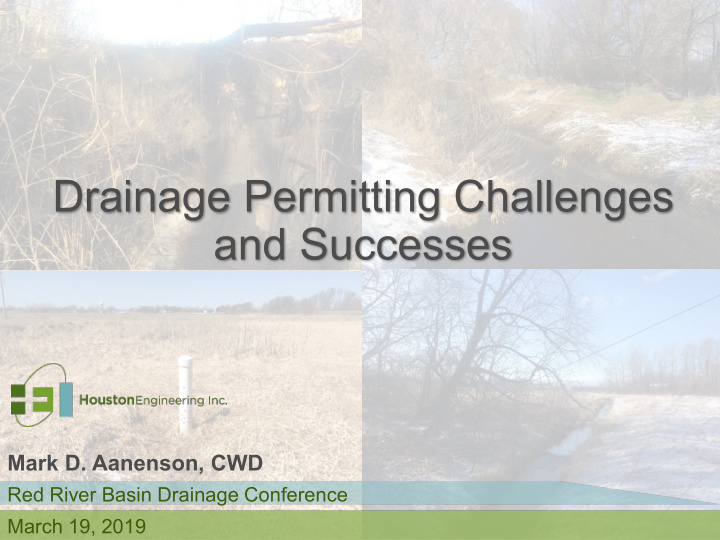



Drainage Permitting Challenges and Successes Mark D. Aanenson, CWD Red River Basin Drainage Conference March 19, 2019
Permit Programs Minnesota TIMIN G USACE Section 404 Minnesota Protected Waters and Wetlands Minnesota Wetland Conservation Act Watershed Districts USFWS Drainage Easement Parcels Calc Fens, Western Prairie Fringed Orchid, Northern Long Eared Bat Cultural Resources North Dakota USACE Section 404 North Dakota Sovereign Lands Water Boards USFWS Drainage Easement Parcels Northern Long Eared Bat Cultural Resources
Drainage Permitting Challenges TIMIN G Five Permitting Challenges 1) Wetland delineations in the RRV 2) Lateral effect (drainage setbacks) 3) Existing ditch bottoms - wetlands? – WOUS 2015 rule 4) Cultural resources – Section 106 5) Legal ditch repairs
Drainage Projects TIMIN G Repairs of Existing Systems Generally considered exempt activities There are exceptions! New Drainage Systems and Improvements of Existing Systems Not considered exempt activities Impacts to waters and wetlands - mitigation
Delineation Concepts TIMIN G Challenges Soils, vegetation, and hydrology Low topographic relief Not clear upland/wetland soil boundaries (sandy – non-prairie better) Lots of tilled lands – no intact vegetation Lack of regular consistent hydrology Lots of existing drainage Different delineation methodologies
Delineation Concepts TIMIN G
Delineation Successes TIMIN Successes G Discuss the methodology with regulatory agencies – save money Don’t assume if it is tilled it is upland Upland or wetlands LGUs or USACE may need data Get delineation concurrence in writing – Minnesota WCA Form
Lateral Effect of Drainage Systems TIMIN G Challenges Lateral Effect Tables New or drainage improvements Deeper ditches or new ditches or tiles adjacent to a wetland Will they “drawdown” the hydrology of an adjacent wetland
Lateral Effect – Surface Ditches
Lateral Effect – Surface Ditches
County Setback Tables TIMIN G
Setback Distances – Surface Ditches
Setback Distances – Surface Ditches
Lateral Effect Successes TIMIN Successes G Keep the decisions related to field conditions There may not be an exact technical basis for impact analysis There are some technical solutions - fabric barriers, clay caps Mitigation of partial wetlands is not ideal
Permitting Applications for Setback Tables TIMIN G
Existing Ditch Bottoms? Wetlands? TIMIN G
Existing Ditch Bottoms? Wetlands? TIMIN Regulatory Programs G USACE 2015 Rule – ditches constructed in uplands are no longer a WOUS Previous Rule – regulated WCA Incidental wetlands (includes drainage ditches constructed in uplands) – generally processed as a “no loss” determination
NATURAL WETLANDS CONNECT BY DITCH
MN - Potentially not a WOUS, - No Loss ND – WOUS – Potentially no mitigation TIMIN G
Ditch Bottom Successes? TIMIN Successes G Delineate all wetlands Provide good data where permanent losses are anticipated Document adjacent areas (ditches through uplands) Watch for altered natural watercourses
Cultural Resource Surveys Cultural Resource Reports Report Completed by the Cultural Resource Professional Contains a site visit, visual inspection of the project area Pedestrian survey – may use transects – look for artifacts Literature or Records Search of Knows Sites Recommendation/conclusions – “no properties affected” Different levels of surveys – (Class I, II or III)
When do You Need a Cultural Resource Survey? Requested as part of a federal permit or when federal funds are spent on a project. USACE staff will advise on the need for a Cultural Resource Survey Typically structures 50 years old may trigger a Cultural Resource Survey Work in on river banks, historic travel corridors, near knows sites
Culturally Significant Sites TIMIN G
Culturally Significant Sites TIMIN G
Cultural Resource Approval - Successes TIMIN Successes G Timing of the conversation regarding the need for a Cultural Resource Survey Survey Crew or Project Manager get photos of any old bridges, structures, and buildings Note riverbanks Early coordination with USACE Staff – prior to permit submittal
Repairs of Drainage Systems TIMIN G Challenge Repair “…to restore all or a part of a drainage system as nearly as practicable to the same hydraulic capacity as originally constructed and subsequently improved, including resloping of ditches and leveling of spoil banks if necessary to prevent further deterioration, realignment to original construction if necessary to restore the effectiveness of the drainage system….”
Repairs are generally “Exempt” Exceptions Wetland that have been in existence longer that 25 years that will be drained (WCA) – not exempt Lower the level of a public water basin or wetland – need MnDNR approval
Determining the “Repair Grade” TIMIN Can be difficult for systems that have not had recent G repair work Very significant for permitting Petitioned and established in 1907 Construction completed in 1909 1981 Petition to Outlet No as-build plans
Determination of the As-Constructed Alignment 1907 Plan showing the As-Designed Alignment
Determination of the As-Constructed Grade Original design information Survey – existing conditions Soil borings - identify the bottom of excavated open channel ditch
Determination of the As-Constructed Grade Why aren’t all these data lining up? Agencies/Landowners questioning if the proposed work is a repair or improvement. Original design is not “as constructed” Culverts were not installed to the as constructed grade Soil borings were not located over the original ditch centerline Ditch banks can fail and fall into the channel
Why Are Some Culverts Higher Than Your Repair Grade? Most roads weren’t present in 1909 TIMIN G Over the years, sediment accumulated New or replacement culvert placed on top of existing sediment
Why isn’t every boring on grade? i.e. “What is an outlier?”
What May Cause a Boring/Probe to Be Above the Repair Grade TIMIN G Sloughing of channel banks Deposition of coarse sediment Location of boring/probe (not in channel bottom)
SUCCESSES - TAKEAWAYS TIMIN Successes G Requires weighting of many pieces of evidence Cannot rely on a single data point Provide the data to support the repair
TIMIN G QUESTIONS
Recommend
More recommend